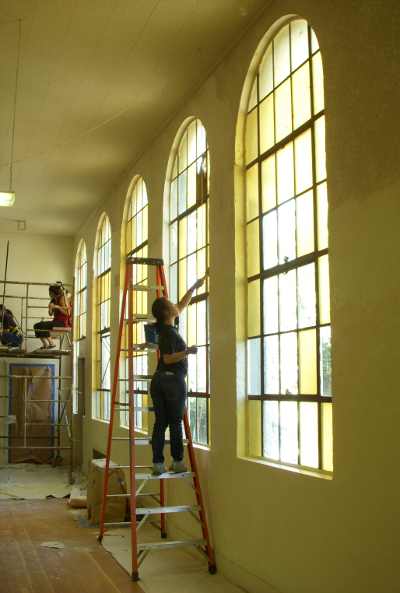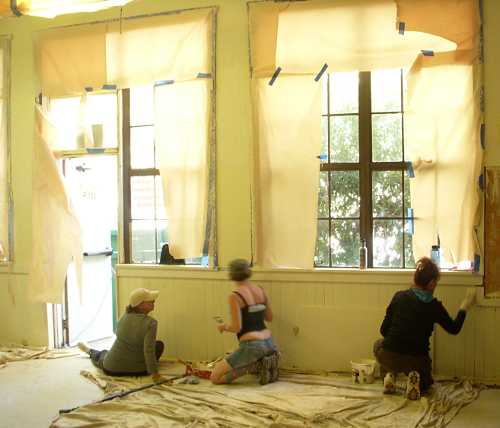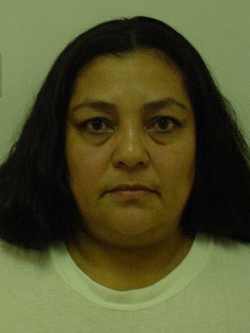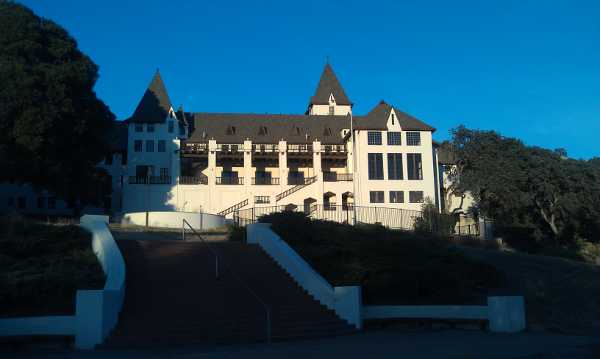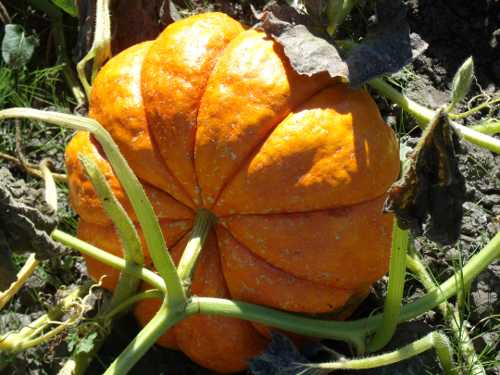
The color on this Cinderella pumpkin at Leonardis Organics in Kelseyville, Calif., will deepen to a dark reddish orange as it matures. Photo by Esther Oertel.
After yesterday’s final farmers’ market of the season, I walked through soil and frost-bitten leaves to photograph pumpkins for today’s column at a local farm, Leonardis Organics in Kelseyville, Calif.
The result of the season’s first frost is that these mostly orange orbs were exposed in the field, no longer hidden by their large living leaves.
Pumpkins and other winter squash will ripen off the vine, so those that are not quite ripe when their vine dies will continue to develop color and flavor, both in the field and after they’re picked.
There are dozens of varieties of pumpkins and a fair number of them are represented in Leonardis’ crop, from large ones with thin flesh for carving Jack-O-Lanterns to small ones with sweet, dense flesh for pies.
Pumpkins are a type of winter squash and share a family tree with summer squashes, cucumbers, and gourds.
In other parts of the English-speaking world, such as Australia, the word “pumpkin” refers to any type of thick-skinned winter squash, rather than the orange-skinned varieties that are exclusively referred to by the moniker here in the United States.
The word itself has an interesting history. It originates from the Greek word for large melon, pepon, which the French adapted to pompon. The British morphed the French word into pumpion, and, finally, American colonists changed that to the word we know today, pumpkin.
The exact origin of pumpkin is not known, but they are believed to be native to North America. The oldest evidence for this are ancient pumpkin-like seeds found in Mexico that are estimated to be from sometime between 7000 to 5500 B.C.
The ancestor of today’s pumpkin was elongated with a crooked neck and was cultivated in ancient American cultures along creek banks in companion plantings with sunflowers and beans.
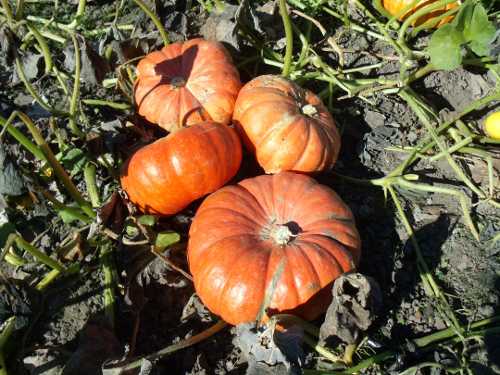
These Cinderella pumpkins at Leonardis Organics in Kelseyville, Calif., are so named because they resemble the pumpkin turned into a coach by the Cinderella's fairy godmother. They're good for eating, as well as for decorative purposes. Photo by Esther Oertel.
These pumpkin relatives were cultivated before maize, the ancestor of modern-day corn. Once maize became a staple crop, ancient farmers grew it with pumpkins and beans using a method known as the “Three Sisters.”
In this tradition, maize stalks served as trellises for the climbing beans, the beans provided stability for the maize and added nitrogen to the soil, and the squash plants sheltered the shallow roots of the corn and shaded the ground, which discouraged weeds and preserved moisture.
These Native American peoples relied on the pumpkin as a food source that sustained them through the winter. They utilized the entire fruit, including the flesh, which they roasted, baked, boiled, and dried; the seeds, which they ate and used medicinally; and the blossoms, which they added to stews.
In addition, the flesh which was dried was ground into flour, and pumpkin shells were dried for bowls and storage containers. Strips of dried pumpkin were even made into mats that could be used for trading.
Pumpkins are grown successfully on every continent save Antarctica. They’re enjoyed in cuisines throughout the world, including China, where, for example, the leaves are used as a vegetable or an ingredient in soup; India, where it’s used in a variety of regional cuisines and sometimes cooked with butter and spices; Thailand, where its flesh is used in curry dishes and small, custard-filled pumpkins comprise a dessert; the Middle East, where it’s enjoyed in sweet dishes; Japan, where it’s used in tempura; Mexico and the southwestern U.S, where the blossoms are enjoyed; Italy, where it stuffs ravioli and flavors beverages; and Kenya, where pumpkin flesh is boiled and the leaves are called seveve and used in popular dishes.
This list, of course, is partial, both in terms of the cuisines listed and the manner in which pumpkin is used, but it serves to show the diversity of ways pumpkin can be prepared. All parts of the pumpkin, its flesh, seeds, leaves, and blossoms, are edible.
Pumpkin seeds, also known as pepitas, are especially healthy. They may be slippery and hard to handle when scooped out of the hollow of a pumpkin, but they’re easily transformed into a delicious toasted snack.
Wash them to remove the bits of fiber that may be clinging to them and pat them dry. Toss them with a bit of oil, lightly salt them, and spread them out on a baking sheet.
Bake them in a low oven, about 250 degrees F, until they’re golden, crisp, and dry, which takes about an hour. Stir them every 10 minutes or so to prevent scorching.
Alternatively, they may be toasted on the stove top in a skillet or in a hotter oven. In both cases, they’ll cook much more quickly, but should be hovered over to prevent burning.
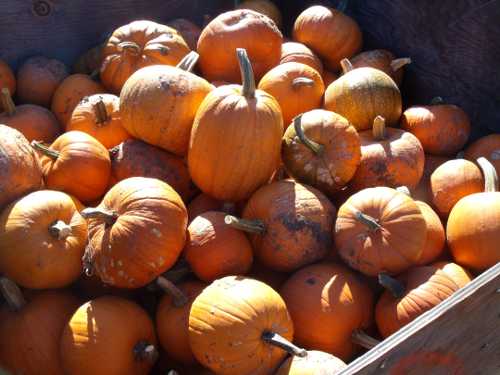
This medley of pumpkins at Leonardis Organics in Kelseyville, Calif. include two which are bred for pies, the New England pie and and sugar pie pumpkins. Photo by Esther Oertel.
Canned pumpkin is quick and convenient for things such as pies, soups, or custards; however, when fresh squashes are available, a bit of effort will yield a lovely home-made puree. If doing this, be sure to use pumpkins that are intended for use in pies or cooking. Pumpkins grown for carving Jack-O-Lanterns have little flesh, and since they’re not bred for eating, the taste is inferior.
To make fresh pumpkin puree, cut a pumpkin into wedges of about 4 or 5 inches and brush the flesh sides with melted butter or olive oil. Arrange them flesh side down in a roasting pan and cover with aluminum foil.
Roast the pumpkin pieces in a 400 degree Fahrenheit oven until the flesh is very tender and may be pierced with a fork, about two hours, turning after the first hour. Remove the foil and let the pumpkin cool.
Once cool, discard any liquid that may have collected, scoop out pumpkin flesh, and puree in batches in a food processor. Transfer the puree to a large sieve or colander with several layers of cheesecloth set over a large bowl. Cover with plastic wrap and place in the refrigerator to drain at least 8 hours or overnight.
Pumpkin is low in calories and sodium, but high in fiber, and the seeds are rich in protein, iron, and B vitamins. The flesh has high stores of beta-carotene, an antioxidant that converts to vitamin A. Research has shown that beta-carotene is helpful in preventing heart disease and some cancers, and even helps delay the aging process.
Today’s recipe is adapted from the medley of roasted vegetables I offered in a culinary demo at yesterday’s Lake County Farmers’ Finest final market of the season. The original recipe utilizes butternut squash, but pumpkin will substitute well.
Use a small to medium-sized cooking pumpkin, cut it into wedges, and then cut into cubes. I find it’s easier to remove the outer skin by cutting it off once the pumpkin’s been cubed. Enjoy!
Roasted pumpkin with apples, onion, and crispy sage
About six cups of cubed fresh pumpkin, skin removed
3 large or 4 medium apples, any variety other than the most tart, peeled and cubed
2 large onions, peeled and cubed
20 or more fresh sage leaves, stems removed
Extra virgin olive oil, ½ cup to crisp sage plus more for roasting
Kosher salt and cracked black pepper
Toss the pumpkin, apple, and onion together in a large bowl with just enough olive oil to coat so each piece is glossy.
Spread mixture on a baking sheet (you may need more than one) and roast in a 400 degree F oven for an hour or so, stirring every 15 minutes, until cubes are fork tender and caramelized. Typically, they will be tender after 30 minutes, but will need to stay in longer to brown.
Meanwhile, heat olive oil over medium-high heat in a small saucepan on stovetop until hot. (It’s ready when a drop of water makes it sizzle.)
Throw in a few sage leaves in the hot oil and cook for a few seconds until crispy. (Be careful as oil may splatter!) The leaves are ready when their green color deepens and they become crisp. If they become brown, they lose flavor. Remove leaves to a paper towel to drain. Repeat until all leaves are crispy.
When roasting process is complete, turn roasted cubes into a large bowl. Crumble sage leaves over mixture and toss to combine. Taste and add more salt and/or pepper, if needed.
Serve warm as a side dish or at room temperature as an autumn salad.
Esther Oertel, the “Veggie Girl,” is a culinary coach and educator and is passionate about local produce. Oertel gives private cooking lessons. She welcomes your questions and comments; e-mail her at This email address is being protected from spambots. You need JavaScript enabled to view it..
Follow Lake County News on Twitter at http://twitter.com/LakeCoNews, on Tumblr at www.lakeconews.tumblr.com, on Facebook at http://www.facebook.com/pages/Lake-County-News/143156775604?ref=mf and on YouTube at http://www.youtube.com/user/LakeCoNews.
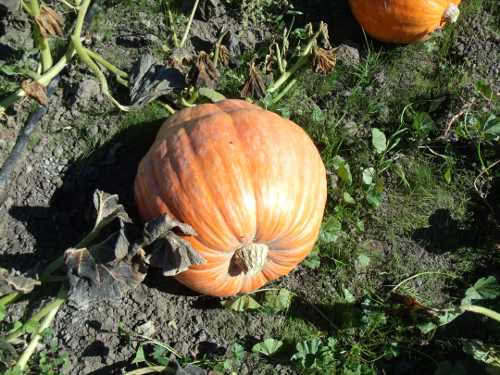
This pumpkin of unknown variety at Leonardis Organics in Kelseyville, Calif., is named Lorrie Gray by Leonardis, from whom he obtained the seeds. Gray is involved with the Lake County Hunger Task Force. Photo by Esther Oertel.

